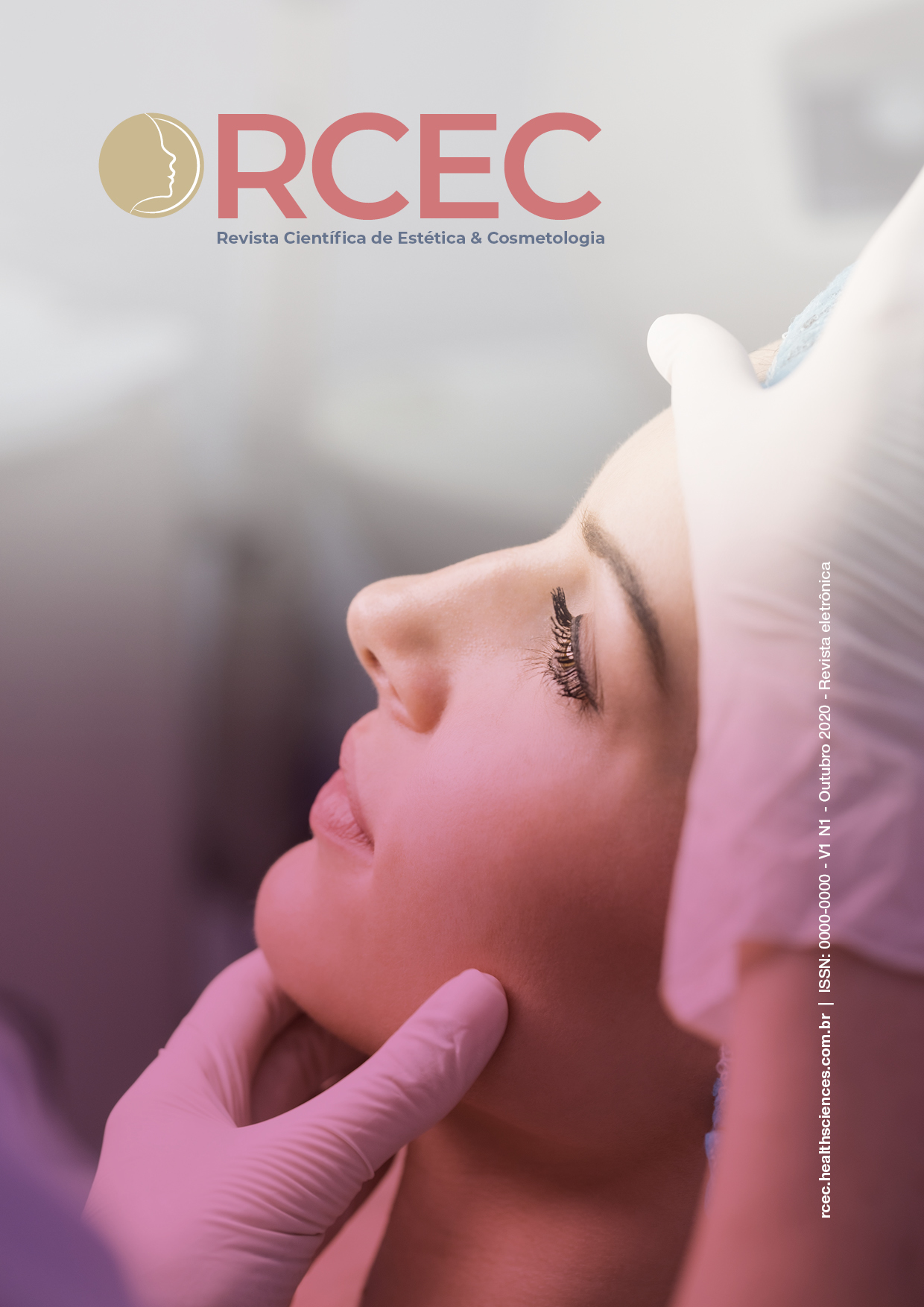Effects of oral administration of hyaluronic acid on skin aging: a review
Main Article Content
Abstract
Introduction: In the human body, the total hyaluronic acid (AH) content found is approximately 15g every 70kg and half is found in the skin more specifically between the dermis and epidermis. With the passing of the years, it is observed a decline of its endogenous production altering its volume, hydration, sustentation and elasticity, leaving the skin with a more aged aspect. Objective: To evaluate the impact of oral supplementation of hyaluronic acid on skin aging. Material and Method: A bibliographic review in the main health databases MEDLINE, LILACS and SCIELO was performed, using the descriptors in Health Sciences (DeCS): hyaluronic acid, skin and skin aging, in Portuguese and English, considering the last 5 years. Result: 51 studies were found, 5 were included and 46 excluded for not meeting the eligibility criteria. The observed studies suggest that the ingestion of AH by oral route increases hydration and decreases expression lines, being a possible treatment in the prevention of skin aging. Its use as an oral supplement is also relatively new compared to other nutrients used for dry skin and its aging. Conclusion: AH has improved the hydration and elasticity of the skin. In this review, the oral supplementation of different doses and molecular weights showed benefits in skin health. However, randomized clinical studies are necessary to confirm its effects and establish the ideal molecular weight, as well as the appropriate dose to minimize the clinical signs of skin aging.
Article Details

This work is licensed under a Creative Commons Attribution 4.0 International License.
Copyright Statement - Policy Proposal for Open Access Journals
Authors who publish in the Scientific Journal of Aesthetics & Cosmetology agree to the following terms: 1 - Authors retain the copyright and grant the journal the right to first publication, with the work simultaneously licensed under the Creative Commons Attribution License allowing the sharing of the work with acknowledgment of the authorship of the work and initial publication in this magazine. 2 - Authors are authorized to assume additional contracts separately, for non-exclusive distribution of the version of the work published in this journal (eg, publishing in institutional repository or as a book chapter), with acknowledgment of authorship and initial publication in this journal. 3 - Authors are allowed and encouraged to publish and distribute their work online (eg in institutional repositories or on their personal page) at any point before or during the editorial process, as this can generate productive changes, as well as increase the impact and citation of published work.
This is an open access article under the CC-BY license
References
Souza VM, Antunes Junior D. Ativos Dermatológicos: Guia de ativos dermatológicos utilizados na farmácia de manipulação para médicos e farmacêuticos. São Paulo: Tecnopress. 2009.
Maia Campos PM, Gianeti MD, Camargo FB Jr, Gaspar LR. Application of tetra-isopalmitoyl ascorbic acid in cosmetic formulations: stability studies and in vivo efficacy. Eur J Pharm Biopharm. 2012 Nov;82(3):580-6.
Yaar M. Molecular mechanisms of skin aging. Adv Dermatol. 1995 Dec;10(0):63-75.
Ross MH, Pawlina, W. Histologia: texto e atlas, em correlação com Biologia celular e molecular. 6.ed. Rio de Janeiro: Guanabara Koogan, 2012. pp. 105, 164.
Ignatova EY, Gurov AN. Principles of extration and purification of hyaluronic acid (Review). Phatm Chem J. 1990 Mar;24(3):211-6.
Pires AM, Macedo AC, Eguchi SY, Santana MH. Microbial production of hyaluronic acid from agricultural resource derivatives. Bioresour Technol. 2010 Aug;101(16):6506-9.
Devlin T M. Manual de bioquímica com correlações clínicas. São Paulo: Editora Blucher. 2007.
Liu L, Liu Y, Li J, Du G, Chen J. Microbial production of hyaluronic acid: current state, challenges, and perspectives. Microb Cell Fact. 2011 Nov 16; 10:99.
Bertolami CN, Berg S, Messadi DV. Binding and internalization of hyaluronate by human cutaneous fibroblasts. Matrix. 1992 Feb;12(1):11-21.
Kajimoto O, Odanaka W, Sakamoto W, Yoshida K, Takahashi T. Clinical effect of hyaluronic acid diet for dry skin -objective evaluation with microscopic skin surface analyzer. J New Rem Clin. 2001; 50:548–60.
Fraser JR, Laurent TC, Laurent UB. Hyaluronan: its nature, distribution, functions and turnover. J Intern Med. 1997 Jul;242(1):27-33.
Gonçalves GMS, Campos PMBG. Ácido Hialurônico na prevenção do envelhecimento cutâneo. Infarma. 2006; 18(?):7-8.
Kim HK, Moon TK, Kim NS. Effect of hyaluronan on wrinkle. Food Style 21. 2007 ;11(0):42–46.
Maia, C. Aplicattion of acid in cosmetic formulations: stability studies and in vivo efficacy. Eur J Pharm Biopharm, v.1B, p.1-10, 2018.
Kawada C, Kimura M, Masuda Y, Nomura Y. Oral administration of hyaluronan prevents skin dryness and epidermal thickening in ultraviolet irradiated hairless mice. J Photochem Photobiol B. 2015 Dec;153:215-21.
Watanabe M, Matsui K, Kondo S. Effects of low molecular weight hyaluronic acid by oral intake to beautify skin -placebo-controlled double-blind comparative study. Jpn Pharmacol Ther.; 2015;43:57–64.
Kawada C, Kimura M, Masuda Y, Nomura Y. Orally administered hyaluronan affects skin dryness and epidermal thickening in photoaged hairless mice. Bioscience, Biotechnology, and Biochemistry. 2016 Mar; 80(6):1192–5.
Oe M, Sakai S, Yoshida H, Okado N, Kaneda H, Masuda Y, Urushibata O. Oral hyaluronan relieves wrinkles: a double-blinded, placebo-controlled study over a 12-week period. Clin Cosmet Investig Dermatol. 2017 Jul; 10:267-73.
Göllner I, Voss W, von Hehn U, Kammerer S. Ingestion of an Oral Hyaluronan Solution Improves Skin Hydration, Wrinkle Reduction, Elasticity, and Skin Roughness: Results of a Clinical Study. J Evid Based Complementary Altern Med. 2017 Oct;22(4):816-823.
Lorencini M, Brohem CA, Dieamant GC, Zanchin NI, Maibach HI. Active ingredients against human epidermal aging. Ageing Res Rev. 2014 May;15(0):100-15.


